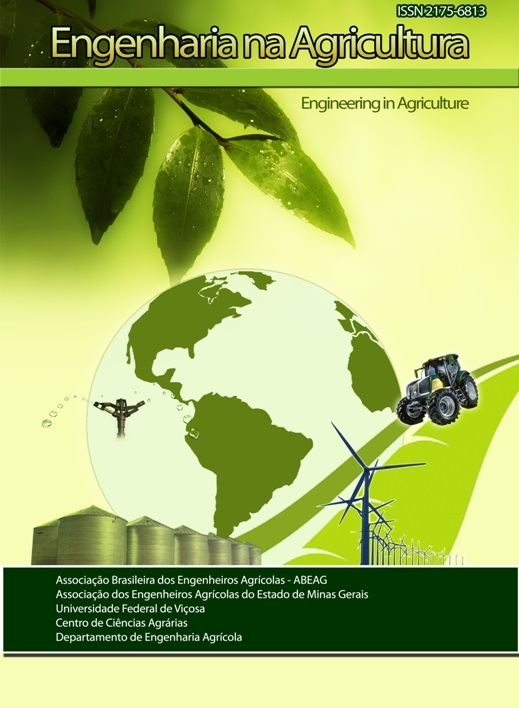Growth evaluation of crossbred heifers raised under tropical conditions
DOI:
https://doi.org/10.13083/reveng.v29i1.11558Keywords:
insemination, growth, resaingAbstract
The objective of this study was to evaluate growth and body development of crossbred Holstein×Gyr calves and heifers raised in tropical conditions. Thirty-two crossbred heifers (Holstein×Gyr) aged between 1 and 1314 days were used. For assessing the animals’ body weight, the heifers were weighed once a week with a chest tape for weighing cattle, using the specification for medium breeds recorded on the tape itself. The experiment was conducted in a completely randomized design. Body weight data were analyzed using linear regression as a function of age, using the R software. We could observe that animals less than 200 days old had a performance estimate of approximately 0.517 kg day-1, while after at 200 days of life, the estimated weight gain was 0.237 kg day-1. Heifers had a higher growth rate before 200 days of age than after this age, which can affect the age at the first calving of the herd. Thus, as the age for the first breeding is linked to the weight of the live animals, the delay in the growth of the calves becomes detrimental to the breeding.
Downloads
References
GARCIA C. S.; FERNANDES A. M.; FONTES C. A. A.; VIEIRA R. A. M.; SANT’ANA N. F.; PIMENTEL V. A. Desempenho de novilhos mantidos em pastagens de capim-elefante e capim-mombaça. Revista Brasileira de Zootecnia, v.40, n.2, p.403-410, 2011.
GASSER C. L.; BEHLKE E. J.; GRUM D. E.; DAY M. L. Effect of timing of feeding a high-concentrate diet on growth and attainment of puberty in early-weaned heifers. Journal of Animal Science. v.84, n.11, p.3118-3122, 2006.
MACIEL R. P.; NEIVA J. N. M.; ARAUJO V. L.; CUNHA O. F. R.; PAIVA J.; RESTLE J.; MENDES C. Q.; LÔBO R. N. B. Consumo. digestibilidade e desempenho de novilhas leiteiras alimentadas com dietas contendo torta de dendê. Revista Brasileira de Zootecnia, v.41, n.3, p.698-706, 2012.
NETO J. M.; CAMPOS J. M. S.; FILHO S. C. V.; LANA R. P.; QUEIROZ A. C.; EUCLYDES R. F. Consumo. digestibilidade. desempenho. desenvolvimento ponderal economicidade de dietas com polpa cítrica em substituição ao feno de capim-tifton 85 para novilhas leiteiras. Revista Brasileira de Zootecnia, v.36, n.3, p.626-634, 2007.
SANTOS G.; LOPES. M.A. Custo de produção de fêmeas bovinas leiteiras do nascimento ao primeiro parto. Ciência Animal Brasileira, v.15, n.1, p.11-19, 2014.
SILVA A. L. VRIES T. J.; FERNANDES E. C.; MARCONDES M. I. Short communication: Development and evaluation of equations to predict growth of Holstein dairy heifers in a tropical climate. Journal of Dairy Science. Champaign. In press, 2020.
TORQUATO J.L. FILHO G. F. S.; JUNIOR J. B. F. S.; DOMINGOS H. G. T.; COSTA L. L. M.; DANTAS M. R. T. Aspectos da utilização de sombreamento em pastagens. PUBVET, v. 6, n. 14, p. 1345-1351, 2012.
YOKOON M. J. MAGNABOSCO C. U.; ROSA G. J. M.; LÔBO R. B.; ALBUQUERQUE L. G. Características reprodutivas e suas associações com outras características de importância econômica na raça Nelore. Arquivo Brasileiro de Medicina Veterinária e Zootecnia, v.64, n.1, p.91-100, 2012.
Downloads
Published
How to Cite
Issue
Section
License
Copyright (c) 2020 REVISTA ENGENHARIA NA AGRICULTURA - REVENG

This work is licensed under a Creative Commons Attribution-NonCommercial 4.0 International License.
Authors who publish with this journal agree to the following terms:
The author(s) authorize(s) the publication of the text in the journal;
The author(s) ensure(s) that the contribution is original and unpublished and that it is not in the process of evaluation by another journal;
The journal is not responsible for the views, ideas and concepts presented in articles, and these are the sole responsibility of the author(s);
The publishers reserve the right to make textual adjustments and adapt texts to meet with publication standards.
From submission, the author is fully conceding the paper's patrimonial rights to the publication, but retaining the owner of its moral rights (authorship and paper's identification) according to Creative Commons Attribution-Noncommercial.








 Licensed by
Licensed by 